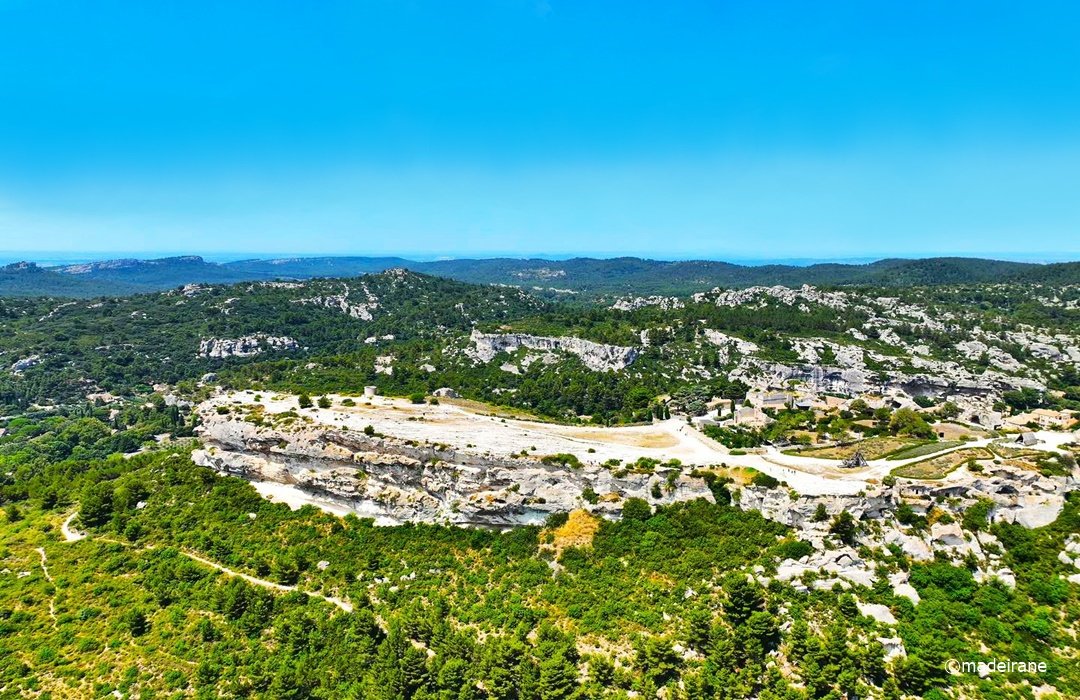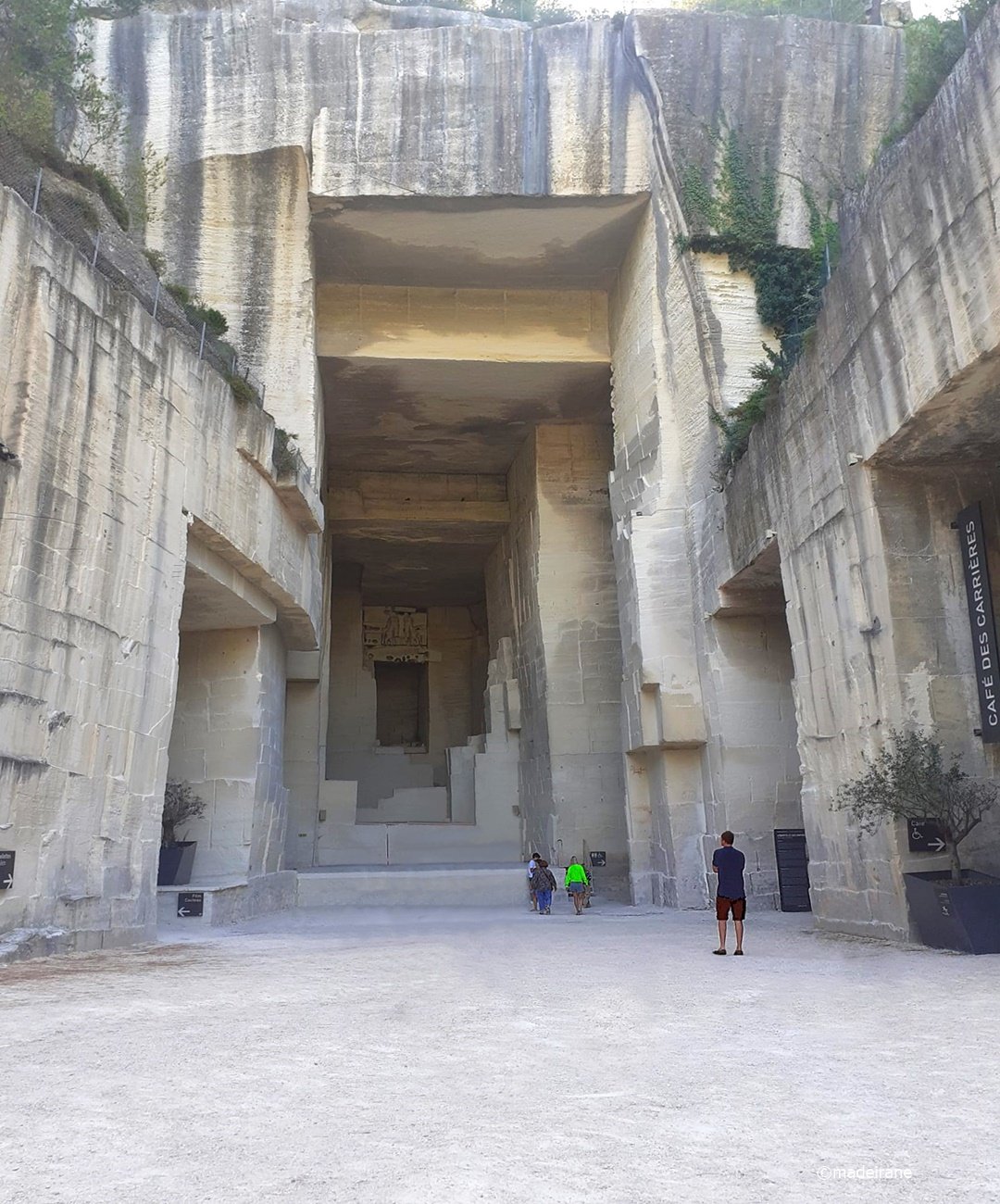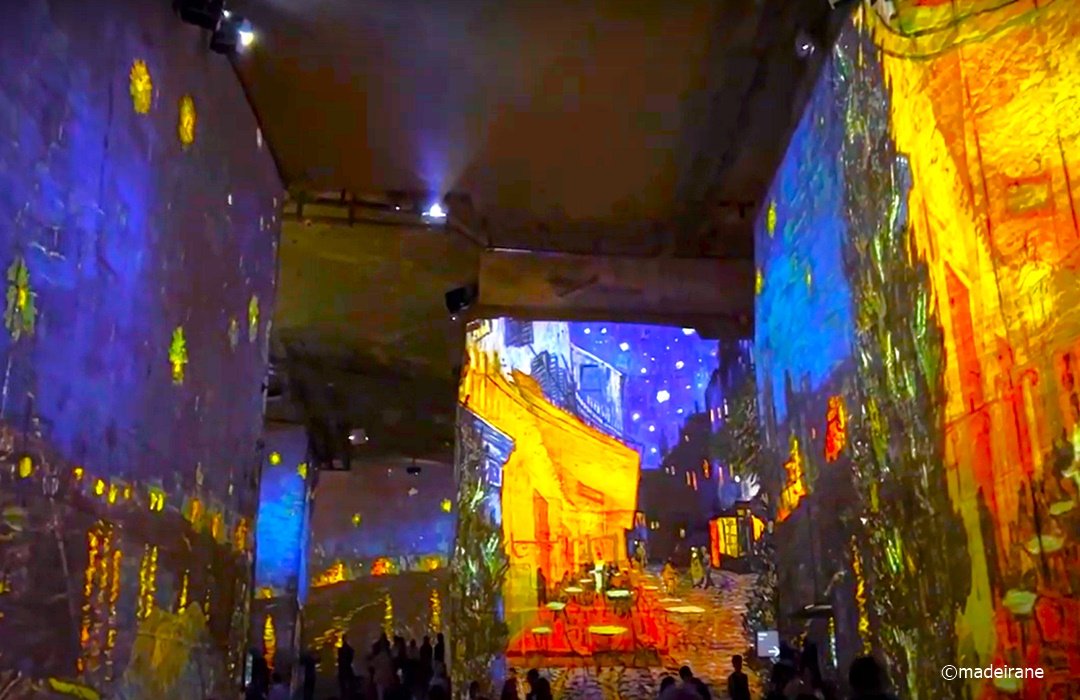Lumiere Carriere in Provence Shows A Magical Story Every Year
3 comments

Today I want to dedicate my review again to my beloved France, which I love in all its manifestations. I have written so much about it, I have been there so much, but I again have an unbearable desire to visit it again and go where my foot has not yet stepped and where I have stepped too. In this country there are cities that are very memorable and to which I want to return. We visited it last year and watched Van Gogh's exhibition.

In Provence, near the picturesque rocky village of Les Baux, popular in tourist circles, there is a place with the ominous name Hell's Valley. A person who doesn't know about it, immediately thinks of some kind of mass executions, battles with a huge number of fallen; about hard labor, leading to the mass deaths of workers; about an unbearable climate, etc. Nothing of the sort! Hell's Valley has never known all the horrors I have listed. It got its name for the white or light gray (depending on the lighting) limestone cliffs, eaten away by centuries of erosion and because of this having received an unusual shape that defies any comparison.

Apart from the nature, the Valley of Hell was interesting to me for two banal tourist reasons. The first was to see the village of Les Baux de Provence itself, which is included in the official list of the most beautiful villages in France. I already wrote about them.

The second reason was to visit the dream factory operating in the quarries of the Carrières de Lumiere. Since Les Baux and Carrières de Lumieres are located next to each other, if anyone is interested in the nuances of parking, all this can be read in my previous story.
Any rock from this valley is a real natural masterpiece. Many modern sculptors would burst with envy, seeing such monumentality, such flights of fancy and such a wealth of forms. And even if there were no shows in Hell Valley, we still would not refuse a walk around its territory.

According to legend, the valley in ancient times was a meeting place for witches and other evil spirits. They allegedly periodically flew here for a sabbath.
But this myth associated with the Valley of Hell, although we live in the far from dense 21st century, I still consider it more harmless than another one, which is reproduced every now and then in information sources for tourists. So, myth No. 2 has literary roots. According to this myth, the landscapes of the valley inspired Dante Alighieri to describe "Hell" in the "Divine Comedy".

In fact, the full picture of the poet's wanderings after his expulsion from Florence has never been established. There is no evidence to support the fact that Dante ever lived in Provence. Local poet Frederic Mistral wrote a poem about it, and over time, they transformed into a categorical statement, which was adopted by guides and settled in guidebooks.

And if we are talking about the Valley of Hell as a source of inspiration, then I would mention not the dubious story about Dante, but the real projects of artists who found in these parts the optimal place to implement their plans. And these ideas subsequently turned out to be good for this region.

You know, there are such settlements whose existence directly depends on a single manufacturing enterprise. As soon as this production is closed for some reason, then it is considering that this village has died. The same could well have happened to the village of Les Baux, if it had not had a pleasant "appearance" and a history with a castle destroyed on Richelieu's orders. However, it is not a fact that only this would have saved it from desolation.

Initially, the Valley of Hell was known as a place for mining limestone, and in the 20s of the XIX century, bauxite deposits were discovered here. Incidentally, the discovered ore received its name from the name of the closest geographical point to the deposit, i.e. Le Baux. And the quarries were successfully exploited until the mid-30s of the last century - until bauxite mining ceased to be profitable here.

The first person to pay attention to the abandoned quarries was one of the iconic figures of French culture - Jean Cocteau. It was in the Valley of Hell that he shot his famous film "The Testament of Orpheus". Later, in the Cocteau Museum in Menton, I saw photographs of the places where Cocteau worked on his films.

In the 70s, after the death of Jean Cocteau, the ambiance of the quarries was appreciated by another creative person - Albert Plesi, editor-in-chief of the newspaper "Le Parisien". Inspired by the creative ideas of the Czech set designer Josef Svoboda, who actively used the latest optical and electronic technologies for his time in staging performances, Plesi was fired up by the idea of using the former quarries as a place for holding bright and exciting audiovisual shows.
I would like to point out that there is no time limit for viewers in the hall. This means that you can watch the entire 35-minute show and stay for the following shows for as long as you want. Or, if you are late for the show, you can easily make up for what you missed by waiting for the next show.

Having read the warnings of "seasoned" tourists about the cold in the Carrières de Lumieres, we took with us warm sweaters. As it turned out - in vain. At 35 degrees on the streets of the village of Les Baux, in the caves we were even very comfortable. However, everyone has different ideas about warmth and cold. Therefore, I will not dissuade you from using warm clothes. But if you want to sit on a stone bench, then be sure to take a thicker mat with you.

Since 2012, the themes of the shows are the works of masters of European art from different periods. Each multimedia show is shown for a year, after which it is replaced by a show with other "heroes". In short breaks between sessions, 3D pictures are shown of abstract topics - mainly flora and fauna.

During the show, paintings, sculptures and frescoes came to life on the walls, columns, ceiling and floor. Of course, this event does not replace visiting museums with the originals of these works of art and reading the relevant literature, but I cannot help but appreciate the work done by its authors.

Excellent projection equipment, light and sound, maximally playing out the unusual relief and acoustics of the caves. I would also like to praise the level of musical accompaniment. I don't know how it was in the previous and subsequent shows, but the music chosen by the authors of the program not only corresponded to the spirit of that time. It almost perfectly fit the video sequence, and the accents made on various details of the paintings and sculptures practically coincided with the musical accents.

In other words, we were shown a high-quality and sometimes fascinating 3D show, although not one that evoked wild delight, where both the artistic and musical parts looked organic.
During the show, you can freely walk around the cave, encountering characters created by the authors of the show. In my school and student years, I really enjoyed flipping through the pages of albums and art books, armed with a magnifying glass - to examine how certain fragments of paintings were painted, how this or that part of a sculpture looked close up. Therefore, the show at the Carrière de Lumiere delighted me with the richness and unexpectedness of the angles.

And yet, I do not agree with the critics of this show, who claim that this way of showing paintings and sculptures is a mockery of the originals. The show, rather, “animates” the works and gives us the opportunity to see in them some little things that previously eluded our gaze, and, therefore, makes us think about questions that had not occurred to us before.
I think that such projects are useful because they promote real high Art, and not dubious art revelations of imaginary geniuses, supposedly endowed with a deep meaning which only a few can comprehend.

For each show that is shown in the Carrières de Lumiere, the best and most significant works of those people who can be called a Phenomenon in world culture are selected. And if, after watching this show, someone sits down to read books and articles dedicated to its heroes, rushes to art galleries, asks parents to buy him brushes and paints and/or send him to art school, then this can only be welcomed.

For me, this Provencal "dream factory" has caused another attack of cultural nostalgia for one of my favorite periods in art... Wonderful laser projections, lively, interesting, different images everywhere, the performance is accompanied by music, considering the size of the room, you feel like you are inside some kind of fairy-tale magic.
💝💝💝💝💝💝💝💝💝💝
With love @madeirane
Photos are taken by me.
© 2024
Translated fro Lithuanian with DeepL.com (free version)
Šiandien savo apžvalgą vėl noriu skirti savo mylimai Prancūzijai, kurią myliu visomis jos apraiškomis. Esu tiek daug apie ją rašęs, tiek daug joje buvęs, bet vėl kyla nepakeliamas noras vėl ją aplankyti ir nukeliauti ten, kur mano koja dar nebuvo įžengusi ir kur aš taip pat esu įžengęs. Šioje šalyje yra miestų, kurie labai įsimintini ir į kuriuos norisi sugrįžti.
Provanse, netoli turistų pamėgto vaizdingo uolėto Les Baux kaimelio, yra vietovė grėsmingu pavadinimu Pragaro slėnis. Žmogus, kuris apie jį nežino, iškart pagalvoja apie kažkokias masines egzekucijas, mūšius su daugybe kritusiųjų; apie sunkų darbą, dėl kurio masiškai miršta darbininkai; apie nepakenčiamą klimatą ir pan. Nieko panašaus! Pragaro slėnis niekada nepažinojo visų mano išvardytų baisybių. Savo pavadinimą jis gavo dėl baltų arba šviesiai pilkų (priklausomai nuo apšvietimo) kalkakmenio uolų, šimtmečių erozijos išgraužtų ir dėl to įgavusių neįprastą formą, kuriai neįmanoma prilygti.
Be gamtos, Pragaro slėnis man buvo įdomus dėl dviejų banalių turistinių priežasčių. Pirmoji - pamatyti patį Les Baux de Provence kaimą, kuris įtrauktas į oficialų gražiausių Prancūzijos kaimų sąrašą. Apie juos jau esu rašęs.
Antroji priežastis buvo apsilankymas svajonių fabrike, veikiančiame Carrières de Lumiere karjeruose. Kadangi Les Baux ir Carrières de Lumieres yra vienas šalia kito, jei kam nors įdomūs automobilių stovėjimo niuansai, visa tai galima perskaityti ankstesniame mano pasakojime.
Bet kuris šio slėnio akmuo yra tikras gamtos šedevras. Daugelis šiuolaikinių skulptorių sprogtų iš pavydo, matydami tokį monumentalumą, tokius fantazijos skrydžius ir tokią formų gausą. Ir net jei pragaro slėnyje nebūtų parodų, vis tiek neatsisakytume pasivaikščioti po jo teritoriją.
Pasak legendos, slėnis senovėje buvo raganų ir kitų piktųjų dvasių susibūrimo vieta. Jos esą čia periodiškai skrisdavo šabakštynų.
Tačiau šį su Pragaro slėniu siejamą mitą, nors ir gyvename toli gražu ne tankiame XXI amžiuje, vis dėlto laikau nepavojingesniu už kitą, kartkartėmis atkuriamą turistams skirtuose informaciniuose šaltiniuose. Taigi mitas Nr. 2 turi literatūrinių šaknų. Pasak šio mito, slėnio peizažai įkvėpė Dantę Aligjerį aprašyti „Pragarą“ „Dieviškojoje komedijoje“.
Iš tiesų, pilnas poeto klajonių po ištrėmimo iš Florencijos vaizdas niekada nebuvo nustatytas. Nėra jokių įrodymų, patvirtinančių faktą, kad Dantė kada nors gyveno Provanse. Vietinis poetas Frederikas Mistralis apie tai parašė eilėraštį, o laikui bėgant jie virto kategorišku teiginiu, kurį perėmė gidai ir nusistovėjo žinynuose.
O jei kalbame apie Pragaro slėnį kaip įkvėpimo šaltinį, tuomet norėčiau paminėti ne abejotiną istoriją apie Dantę, bet realius menininkų projektus, kurie šiose vietose rado optimalią vietą savo planams įgyvendinti. Ir šios idėjos vėliau pasirodė esančios naudingos šiam regionui.
Žinote, yra tokių gyvenviečių, kurių egzistavimas tiesiogiai priklauso nuo vienos gamybos įmonės. Kai tik ši gamyba dėl kokių nors priežasčių uždaroma, manoma, kad ši gyvenvietė mirė. Tas pats galėjo nutikti ir Les Baux kaimui, jei jis nebūtų turėjęs malonios „išvaizdos“ ir istorijos su Rišeljė įsakymu sugriauta pilimi. Tačiau nėra faktas, kad tik tai būtų jį išgelbėję nuo apleidimo.
Iš pradžių Pragaro slėnis buvo žinomas kaip kalkakmenio gavybos vieta, o XIX a. 20-ajame dešimtmetyje čia buvo atrasti boksito telkiniai. Beje, aptiktos rūdos pavadinimas kilo nuo arčiausiai telkinio esančio geografinio taško pavadinimo, t. y. Le Baux. Ir karjerai buvo sėkmingai eksploatuojami iki praėjusio amžiaus 30-ųjų metų vidurio - kol boksito gavyba čia nustojo būti pelninga.
Pirmasis žmogus, atkreipęs dėmesį į apleistus karjerus, buvo viena iš kultinių prancūzų kultūros figūrų - Žanas Kokto (Jean Cocteau). Būtent Pragaro slėnyje jis nufilmavo savo garsųjį filmą „Orfėjo testamentas“. Vėliau Mentone esančiame Cocteau muziejuje mačiau nuotraukų, kuriose užfiksuotos vietos, kuriose Cocteau dirbo prie savo filmų.
Septintajame dešimtmetyje, mirus Jeanui Cocteau, karjerų atmosferą įvertino kitas kūrybingas žmogus - laikraščio „Le Parisien“ vyriausiasis redaktorius Albert'as Plesi. Įkvėptas čekų scenografo Josefo Svobodos, kuris savo laiku aktyviai naudojo naujausias optines ir elektronines technologijas spektakliams statyti, kūrybinių idėjų, Plesi užsidegė mintimi panaudoti buvusius karjerus kaip vietą, kurioje būtų galima rengti ryškius ir įdomius audiovizualinius šou.
Norėčiau atkreipti dėmesį, kad žiūrovams salėje nėra jokio laiko limito. Tai reiškia, kad galite žiūrėti visą 35 minučių trukmės pasirodymą ir pasilikti į kitus pasirodymus tiek, kiek norite. Arba, jei pavėlavote į laidą, galite lengvai atsigriebti už tai, ką praleidote, laukdami kitos laidos.
Perskaitę „patyrusių“ turistų perspėjimus apie šaltį Carrières de Lumieres, pasiėmėme su savimi šiltus megztinius. Kaip paaiškėjo - veltui. Esant 35 laipsniams Les Baux miestelio gatvėse, urvuose jautėmės net labai patogiai. Vis dėlto kiekvienas turi skirtingą supratimą apie šilumą ir šaltį. Todėl neatspėsiu jūsų nuo šiltų drabužių naudojimo. Tačiau jei norite sėdėti ant akmeninio suoliuko, būtinai su savimi pasiimkite storesnį kilimėlį.
Nuo 2012 m. parodų temos - įvairių laikotarpių Europos meno meistrų darbai. Kiekviena multimedijos paroda rodoma vienerius metus, po to ją keičia paroda su kitais „herojais“. Per trumpas pertraukas tarp seansų rodomi 3D paveikslai abstrakčiomis temomis - daugiausia floros ir faunos.
Parodos metu ant sienų, kolonų, lubų ir grindų atgyja paveikslai, skulptūros ir freskos. Žinoma, šis renginys nepakeičia apsilankymo muziejuose su šių meno kūrinių originalais ir atitinkamos literatūros skaitymo, tačiau negaliu neįvertinti jo autorių atlikto darbo.
Puiki projekcinė įranga, šviesa ir garsas, maksimaliai atskleidžiantys neįprastą urvų reljefą ir akustiką. Taip pat norėčiau pagirti muzikinio akompanimento lygį. Nežinau, kaip buvo ankstesnėse ir vėlesnėse laidose, bet programos autorių parinkta muzika ne tik atitiko to meto dvasią. Ji beveik tobulai derėjo prie vaizdo siužeto, o įvairių paveikslų ir skulptūrų detalių akcentai praktiškai sutapo su muzikiniais akcentais.
Kitaip tariant, mums buvo parodytas kokybiškas ir kartais užburiantis 3D šou, nors ir nekeliantis laukinio susižavėjimo, kuriame ir meninė, ir muzikinė dalys atrodė organiškai.
Spektaklio metu galite laisvai vaikščioti po urvą ir susitikti su spektaklio autorių sukurtais personažais. Mokykliniais ir studentiškais metais man labai patiko vartyti albumų ir meno knygų puslapius, apsiginklavus padidinamuoju stiklu - tyrinėti, kaip nutapyti tam tikri paveikslų fragmentai, kaip iš arti atrodo viena ar kita skulptūros dalis. Todėl paroda „Carrière de Lumiere“ mane sužavėjo kampų turtingumu ir netikėtumu.
Ir vis dėlto nesutinku su šios parodos kritikais, teigiančiais, kad toks paveikslų ir skulptūrų rodymo būdas yra pasityčiojimas iš originalų. Ši paroda veikiau „atgaivina“ kūrinius ir suteikia mums galimybę juose įžvelgti kai kurias smulkmenas, kurios anksčiau išsprūsdavo iš mūsų žvilgsnio, todėl priverčia susimąstyti apie klausimus, kurie anksčiau mums nebuvo kilę.
Manau, kad tokie projektai naudingi, nes skatina tikrą aukštąjį meną, o ne abejotinus įsivaizduojamų genijų meno apreiškimus, neva apdovanotus gilia prasme, kurią suvokti gali tik nedaugelis.
Kiekvienai Carrières de Lumiere rodomai parodai atrenkami geriausi ir reikšmingiausi kūriniai tų žmonių, kuriuos galima vadinti pasaulinės kultūros fenomenu. Ir jei pažiūrėjęs šią parodą kas nors prisėda skaityti knygų ir straipsnių, skirtų jos herojams, skuba į meno galerijas, prašo tėvų nupirkti jam teptukų ir dažų ir (arba) pasiųsti į meno mokyklą, tai galima tik pasveikinti.
Man šis Provanso „svajonių fabrikas“ sukėlė dar vieną kultūrinės nostalgijos priepuolį vienam iš mano mėgstamiausių meno laikotarpių... Nuostabios lazerių projekcijos, visur gyvi, įdomūs, skirtingi vaizdai, spektaklį lydi muzika, turint omenyje patalpos dydį, jautiesi tarsi atsidūręs kažkokios pasakų magijos viduje.








Comments